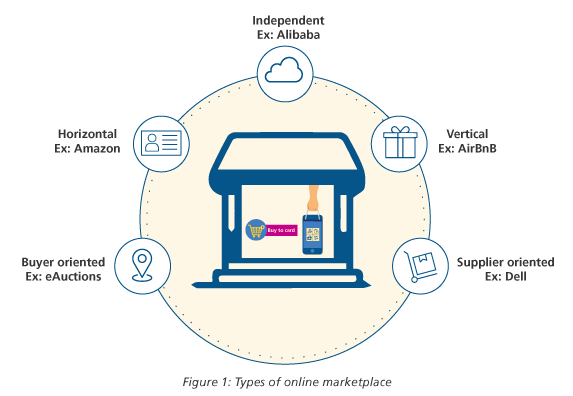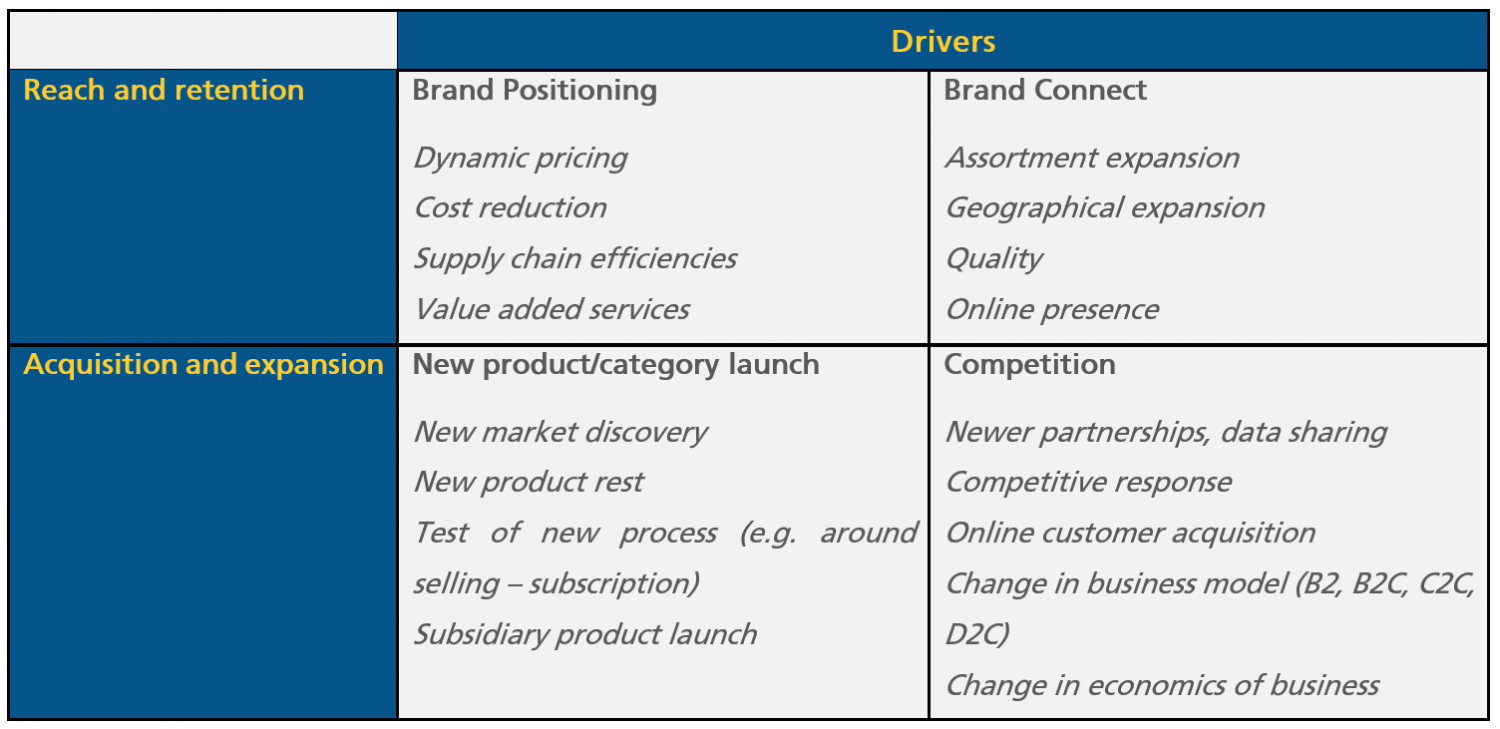Considering marketplace selling as a part of a Brand’s omnichannel strategy – The advantages & tradeoffs
The most common disposition of e-commerce is expressed through online marketplaces. Amazon, Flipkart, eBay, Airbnb, and many others are online marketplaces that facilitate commercial interaction between sellers and buyers, both in D2C, B2B, and B2C models. Most of the well-established online marketplaces provide additional channels for businesses with relatively low costs to establish the additional channel and related value-added services. Over the past decade, marketplaces have the way we shop, travel, eat, work, and learn.
To quote a study by McKinsey (1), “…As a result of marked shifts in consumer behavior during the COVID-19 pandemic, digitization has accelerated even further: 40 percent of consumers are buying more online than they had previously done. Before COVID-19, marketplaces rang up half of global online sales—$2 trillion on the top 100 sites…”
What makes an online marketplace?
The fundamental characteristics of the marketplaces offer benefits to both buyers and sellers. A marketplace platform that has technology and business enablers reduces time-to-market for sellers to add another channel to enhance their revenue streams. The buyers benefit from the availability of multiple brands and sellers at a single channel, enhancing the overall experience, often benefitting from the feedback mechanism about brands, products, and sellers such platforms offer.

- A technology platform: an online platform that offers foundational services that enable online commerce across interaction channels, like, but not limited to, product catalog, digital marketing, payment integration, customer management, and supply chain. These foundational services reduce time-to-market to launch the services. Besides the foundational services, the platform has an existing customer base. It’s have been seen over the last two years that many small and big merchants were able to adopt online channels and expand to newer customers with relative ease. A provider generally operates these platforms.
- Multiple merchants and brands: Amazon or eBay do not own all the products that are sold on their platforms. They onboard various merchants with portfolios of products and brands that are sold on the platform. This signature feature of online marketplaces has been a main contributor to their success. As we will see later, merchants and marketplaces have various operating models.
- A circle of trust/feedback: unlike a traditional marketplace an online product cannot be physically experienced, nor a reputation check of the seller be conducted in an online world hence rating/review systems of products and sellers are considered necessary – and some of the more successful marketplaces attribute their success to earning the trust of buyers and sellers.
Types of online marketplaces

- Horizontal and vertical:
This classification refers to the industry segment a marketplace caters to. Vertical marketplace caters to all segments of a particular industry group with limited but industry specific product inventory leading to efficiency in supply chain and inventories. Uber and Airbnb are typical examples. On the other hand, a horizontal online marketplace combines various retailers of several industries in an online one-stop shop to reach wider consumers. For example, Amazon is a good example of horizontal e-commerce, where product categories are well spread. - Other types of online marketplaces, which are often classified loosely as independent, supplier oriented, and buyer oriented are variations of B2B marketplaces. Alibaba.com is a typical example of an independent marketplace as it is a horizontal B2B marketplace.
- • Supplier (or buyer)-oriented marketplaces have large suppliers (buyers) being connected to fewer buyers (suppliers), respectively. Buyer oriented marketplaces are typically auction sites for large buyers of services and goods.
Why should brands consider marketplaces?
Marketplaces are uniquely positioned in a product’s life cycle in the manufacturing to consumption continuum, as they offer competitive differentiation for the seller and convenience for buyers. It’s important that the benefits of an online marketplace platform are accrued through a strategic fit of an additional channel – defined by reach, customer conversion/retention and brand connect.
Marketplace benefits for the consumer:
- Marketplaces offer convenient accessibility to a wide assortment of products, brands, and sellers. It’s important that brands ensure availability and careful selection of products as it affects brand reputation and performance.
- Purchase options are not limited by geographical proximity to the seller. Marketplaces increase the reach of the product and services. However, this reach needs to be carefully calibrated through supply chain efficiencies, which if not properly addressed might lead to a negative perception of the brand.
- Marketplaces offer features of publishing reviews of products and services, establishing their and the seller’s trust ratings without investing in expensive marketing campaigns.
- The technology platform offers algorithms for real-time and transparent information on pricing, availability, offers (without haggling), and delivery timelines. These algorithms also help in managing supply and demand dynamics over seasonal variations in consumption patterns.
Marketplace benefits for the seller:
- Can set up an online storefront with significantly lower capex and opex and time to market. This is important for D2C brands. It has been seen that many brands started to grow into multichannel operations by building their brands through marketplaces by reaching a potentially large number of consumers without an incremental increase in the cost of customer acquisition.
- One of the primary advantages of a marketplace for brands and sellers is the provision of value-added services, such as various analytics, digital marketing channels, and media/content services. These value-added services boost brand partnerships, profitability, and strategic business growth.
- Sellers can choose the suitable business models – subscription, commission, etc. ensuring customer retention and loyalty.
Tradeoffs in an online marketplace
- Multiplicity of buyers and sellers makes the retention of customers and buyers a challenge. These can be mitigated by maintaining quality of service for consumers and evolving business models to engage sellers.
- Marketplaces often do not exercise control over the quality of products/services and timeliness of delivery. However well-established marketplaces do develop a review mechanism to rate the product, but it is not entirely foolproof.
- Price competition and transaction-based commission models have an impact on the profitability of sellers. This however is mitigated by sales volumes and lower marketing and customer acquisition costs.
- Business policies and backend processes of the platform affect the sales volumes of sellers.
Key considerations for participating in an online marketplace.
As mentioned earlier, participating in marketplaces needs to be a strategic decision with careful consideration of factors at play, as by the inherent nature of marketplaces the impact on brand and customers can be significant. Let’s try to develop a framework – if there is at least one motivation of the brand/seller that resonates with drivers in each of the boxes – the brand should seriously consider adopting a marketplace. If the alignment doesn’t cover all the boxes, additional due diligence might be required.

How to measure the success of a marketplace initiative?
As indicated previously, the key dimensions for online marketplace platforms are reach, retention, acquisition, and expansion as an interplay between business and customers. It is natural that the success of the marketplace should reflect this interplay. Though individual businesses can define what success means to them but key metrics, indicated below, aligned to the dimensions typically provide enough data to infer success or failure.

The metrics indicate the “what”, but it is important to know the “why”. It’s important to hear the voice of the customer no matter what business considerations prompt additional online channels.
Conclusion
Marketplaces funnel multi-trillion-dollar sales and their adoption has accelerated even further post-pandemic. Buyers and suppliers have different advantages and motivations to adopt a marketplace. While it is advantageous for buyers, a supplier and brand should carefully weigh the considerations – which are generally favorable for a quality brand that makes online channels an integral part of its business strategy. The conveniences offered by a marketplace may have a negative impact on brand connection and perception, and customer retention if the motivations are not carefully calibrated, not supported by efficient support processes, and a poor technical platform.
LTIMindtree’s digital marketing and commerce offerings help organizations design and realize outcome driven experiences across different stages of the customer journey with personalized content and frictionless commerce. Explore digital marketing & E-commerce capabilities here.
References
1. https://www.mckinsey.com/industries/retail/our-insights/moving-past-friend-or-foe-how-to-win-with-digital-marketplaces
2. https://www.nibusinessinfo.co.uk/content/types-e-marketplace
3. https://www.sharetribe.com/academy/measure-your-success-key-marketplace-metrics
More from Roosha Sarkar
Introduction Research labs have evolved beyond their traditional roles, exerting both positive…
Latest Blogs
Introduction What if training powerful AI models didn’t have to be slow, expensive, or data-hungry?…
Pharmaceutical marketing has evolved significantly with digital platforms, but strict regulations…
Leveraging the right cloud technology with appropriate strategies can lead to significant cost…
Introduction The financial industry drives the global economy, but its exposure to risks has…




